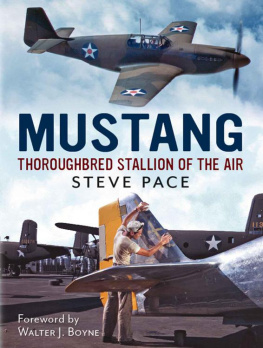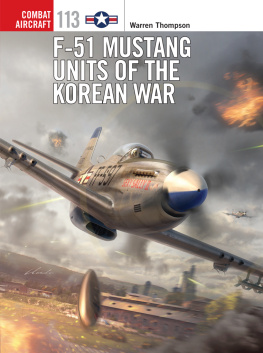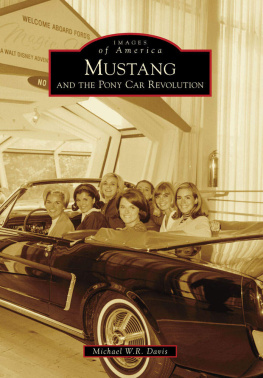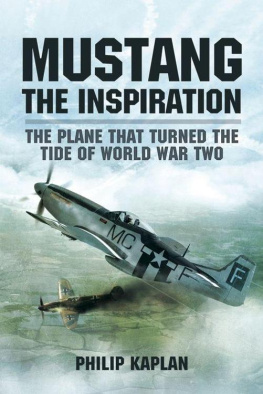MUSTANG
MUSTANG
THOROUGHBRED STALLION OF THE AIR
STEVE PACE
EDITORS NOTE
With regards to the German fighter Bf 109, there is confusion as to why it is also referred to as the Me 109. Bf stands for Bayerische Flugzeugwerke, the company that built the aircraft. As the Bf 109 was developed by Willy Messerschmitt who worked at Bayerische Flugzeugwerke before 1938, the fighter including the heavy twin-engine fighter/destroyer Bf 110 is correctly identified as the Bf 109. However, in 1938, Bayerische Flugzeugwerke became part of the Messerschmitt A.G founded by Willy Messerschmitt that year. Therefore, all aircraft designed 1938 onwards were called Me for Messerschmitt while the Bf 109 was already in production. Although eyewitness accounts from pilots, etc, in this book erroneously refer to the fighter as the Me 109, such references have not been corrected due to their historical value.
To my first, my last love.
Fonthill Media Limited
Fonthill Media LLC
www.fonthillmedia.com
First published in the UK and USA 2012
British Library Cataloguing in Publication Data:
A catalogue record for this book is available from the British Library
Copyright Steve Pace, 2012
ISBN: 978-1-78155-051-9 (HARDBACK)
ISBN: 978-1-78155-107-3 (PRINT)
ISBN: 978-1-78155-092-2 (e-BOOK)
All rights reserved. No part of this publication may be reproduced, stored in a retrieval system or transmitted in any form or by any means, electronic, mechanical, photocopying, recording or otherwise, without prior permission in writing from Fonthill Media Limited
Typeset in 10pt on 13pt Palatino nova.
Printed and bound in England
CONTENTS
ACKNOWLEDGEMENTS
This reference on the Mustang could not have been completed without the generous contributions of the following well-informed persons, many of whom have a working knowledge of this legendary warhorse:
Joseph F. Baugher
Mitchell D. Babarovich (Air-to-Air Photographer Doodle Flight Simulator online, Anacortes, Washington)
Peter M. Bowers
Arjen de Bruine
Col. Walter J. Boyne (USAF, Ret. Author/Historian)
Budd Davisson
Colin Ford
Fred Giles
Martin Kyburz
William T. Larkins (Author/Photographer/Historian)
Sandra Lee (Proofreader)
Craig Libuse
Atlee G. Manthos
Jeff Manthos
Kim McCutcheon (President of the Aircraft Engine Historical Society, Inc.)
John Melson
Norman Mustanger Meyers (Norm is the Project Director of the Mustang Restoration Project at the Chanute Air Museum in Rantoul, Illinois)
Arlon Motsch Jr.
Mark Nankivil
Norman Nattrass
Charles L. Neely
Stan Piet
Mark Von Raesfeld
Jay Slater
Dr. Stephanie A. Smith (Historian Air Force Flight Test Center History Office).
James Stemm (Pima Air & Space Museum,Tucson, Arizona)
Terry L. Sunday
Alan Sutton
Ray Wagner
Mrs. Ray Wagner
Chris Wamsley
Dan Whitney
Mike W. Williams
Stuart (Stu) Wyatt (Jet Pilot Overseas blog)
Aerial photographer Mitchell D. Babarovich captured Impatient Virgin? on Mustang Fly Day. Following its recovery and restoration, this Malcolm Hood-fitted P-51B (N5087F) made its first flight on 24 July 2008. (Photograph by Mitchell D. Babarovich)
INTRODUCTION
The Mustang will forever be remembered as the escort fighter that ranged over German-occupied Europe to beat the Luftwaffe into the ground. Its prowess convinced many that it was the finest fighter of the Second World War. It then took on an entirely different role in the Korean War, serving as a close-air support aircraft that was instrumental in holding back the tide of the North Korean army at the Pusan Perimeter. Heavily laden Mustangs took off from short pierced steel planking runways to interdict the North Korean supply lines and to support the United Nations front line troops.
From the drawing board, the Mustang was a fast, manoeuvrable fighter right out of the gate, but it took time, experience and an American-built, British-designed engine to turn it into the multi-mission superstar that it became. After only indifferent success as a dive bomber as the A-36, the Mustang matured into a superb long-range bomber escort, an area and point interceptor, fighter-bomber, and a swift, capable photographic reconnaissance aircraft.
The Mustang manufacturing programme that began in early 1941 and ended in late 1945 produced three major versions and one minor version of the type: the P-51, A-36, F-6 and TP-51. Two of these, the P-51 and F-6, spawned numerous other variants. They also influenced a great number of proposed versions including a major production spin-off: the side-by-side-bodied Twin Mustang. North American produced 15,586 Mustangs of all types including those built for the US Army Air Forces and five Allied air forces in the Second World War: the Royal Air Force, the Royal Australian Air Force, the Royal Canadian Air Force, the Royal New Zealand Air Force and the South African Air Force. Some 30 other friendly air forces ultimately employed them as well.

More books and feature articles have been written on the Mustang than any other combat airplane. Other popular aircraft have enjoyed lots of ink in their own right but none of them have been represented in as many publications as the legendary Mustang. There are many reasons for this but none of them are more relevant than its overall combat success rating. In short, the Mustang proved to be one of the best combat aircraft in history.
This work on the Mustang comes in 16 parts, each one having its own rationale to explain the numerous aspects of this highly respected fighter plane from the past. The very detailed appendices, tables and sidebars feature first-person accounts and make this 100,000-word volume on the Mustang unlike any other. Moreover, with the help of several serious Mustang photographers and photograph collectors, some 200 photographs, most of which have never been published, are included herein.
The Mustang remains an admired attraction and one cannot go to a major air show anywhere in the free world today where a Mustang is not present. Some are on static display whereas others impress demonstrating their great flying abilities with graceful manoeuvres. Because their fame only continues to grow, there are more surviving Mustang warbirds worldwide than any other Second World War fighter. It is arguably the most popular warbird in the world.
The longevity of this legendary fighter airplane speaks for itself. It was a fighter pilots fighter in the truest sense of that phrase. In the final analysis the Mustang has more than earned this book and also each and every one of the many positive descriptive adjectives it has received.
Steve Pace
Tacoma, Washington, USA
July 2012
James H. Dutch Kindelberger (left) and Leland J. Lee Atwood came from the Douglas Aircraft Company to take over management of the newly formed North American Aircraft, Inc. in 1934. Together they made NAA, Inc., one of the most successful aircraft production companies in aviation history. (















